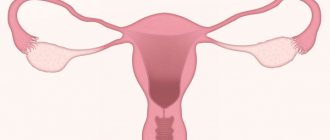Inflammation of the vaginal cervix. Symptoms are nagging pain in the lower abdomen, purulent or mucous discharge, pain during urination and sexual intercourse. Inflammation of the cervix, or cervicitis, refers to inflammation of the narrow lower part of the organ. A healthy uterus is normally covered with epithelium that produces a mucous secretion. This substance plays a protective role and prevents infections from entering the internal cavity. When the secretory function of cells is disrupted, active growth of pathogenic microflora occurs, and symptoms of cervical inflammation develop.
According to statistics, cervicitis is diagnosed in 30% of women of childbearing age. The pathology can be in the cervical canal, then they talk about endocervicitis, or in the vaginal part of the cervix – exocervicitis. The peak incidence is recorded in the age group of 17-28 years, when a woman exhibits maximum sexual activity and rarely uses barrier contraception.
Treatment of cervical inflammation in the initial stage is carried out using conservative methods and does not require radical measures. The prognosis is favorable. But for this, a woman must undergo regular medical examinations and consult a gynecologist when the first symptoms of the disease appear.
You can get examined for signs of cervicitis in Moscow at the Alfa Health Center clinic.
Signs of cervical inflammation
Patient complaints are different for acute and chronic cervicitis.
The main symptoms of inflammation in the cervix:
- purulent or mucous discharge from the genitals;
- pain, heaviness in the uterine area;
- discomfort, burning in the genitourinary tract, aggravated by sex and urination;
- a slight rise in temperature to 37-37.2ºС.
In some cases, the inflammatory process occurs without pronounced clinical signs and is determined by the results of a gynecological smear.
Symptoms and prevention
The main symptom is pain in the lower abdomen. They are rarely acute and a woman may not attach any importance to them. Severe pain occurs when the infection spreads to the peritoneal area. With the development of the inflammatory process, the temperature and severe intoxication may rise (nausea, weakness, dizziness, apathy, sweating). With a chronic course, mild pain in the groin area can become constant. The consequence of advanced inflammation of the uterus is infertility.
The chronic form is more difficult to treat. Untimely or incorrect treatment (erroneously prescribed therapy or self-medication) is the main reason for the transition of the inflammatory process to the chronic stage.
The main preventive measure is avoiding risk factors and being attentive to yourself. Safe sex, hygiene, avoiding abortions, timely examination after childbirth - all this will significantly reduce the risk of infectious processes in the uterus. If suspicious symptoms appear, the best solution is to immediately contact a medical facility for diagnosis and treatment.
Causes of cervicitis
Inflammation of the cervix and appendages can be caused by the following factors:
- sexually transmitted disease: gonorrhea, trichomoniasis, chlamydia and other infections;
- microorganisms that are normally present on the vaginal mucosa;
- mechanical injuries during gynecological operations, conization, childbirth, from the use of the uterine ring, treatment with iodine, dimexide, and other means;
- hormonal disorders;
- antibiotic treatment, chemotherapy courses;
- allergy to latex or substances used in condoms;
- diseases of the female genitourinary system: colpitis, endometritis, cystitis, erosion and others.
A common cause of cervical inflammation is independent, uncontrolled use of antibiotics. Medicines inhibit the beneficial microflora of the vagina and reduce local immunity. Organisms resistant to antibiotics appear in a woman’s biota. These are the most complex cases of mixed infections that require an individual treatment plan.
Risk factors such as young age and frequent changes of sexual partners are also noted.
Risk factors
Primary inflammation begins when the protective mucous layer of the uterus is damaged. There are several main risk factors:
- injury to the uterus and birth canal during difficult childbirth;
- injuries after invasive interventions (curettage, endometrial examination);
- installation and long-term use of an intrauterine device;
- sexually transmitted infections (for example, chlamydia or gonorrhea);
- hypothermia;
- the presence of untreated chronic infections in the body.
The uterine mucosa is very vulnerable after abortion - the uterine cavity becomes an ideal environment for the development of infection against the background of reduced immunity. In such a situation, the infectious process can develop rapidly, easily penetrating into the deep layers of the uterus.
The risk of external infection also increases significantly during menstruation when the mucous layer is rejected. Maintaining hygiene during this period is very important for a woman’s health.
Types of cervicitis due to inflammation
- Purulent. Occurs when infected with a sexually transmitted disease. Purulent cervicitis is characterized by mucous discharge with an unpleasant odor and involvement of nearby organs and tissues in the process.
- Viral. The mucous membrane becomes inflamed when infected with cytomegalovirus, human papillomavirus or other pathogens. The disease may be accompanied by itching and the appearance of polyps.
- Bacterial. Cervicitis develops from vaginosis, when active proliferation of pathogens of the natural microflora of the vagina occurs. Infection from a sexual partner is possible.
- Atrophic. The cause of the disease is thinning of the mucous membranes. Atrophic cervicitis often occurs in women during menopause.
Diseases of the appendages
Diseases of the appendages include damage to the fallopian tubes and ovaries of the uterus.
Salpingitis, oophoritis, salpingoophoritis or adnexitis, pelvioperitonitis are the main inflammatory diseases of the uterine appendages in women.
The main symptoms of the disease may be pain in the pelvis and lower abdomen, bloody or purulent discharge with an unpleasant odor, pain during urination or sexual intercourse, changes in general health, and in severe conditions (pelvioperitonitis) clinical infectious shock.
Diseases of the appendages in women can cause adhesions in the pelvic area, obstruction of the fallopian tubes, and infertility.
Treatment of cervicitis
To select an adequate treatment regimen for cervical disease, the duration, severity of the disease, and cause are taken into account. If cervicitis is infectious, therapy will also be required for the sexual partner.
To treat acute inflammation of the cervix, your doctor may prescribe:
- Antibiotics of the fluoroquinolone or macrolide group. At the same time, it is recommended to take antifungal drugs that will prevent the development of candidiasis;
- Means for restoring microflora. A woman is prescribed medicinal suppositories, gels with lactobacilli;
- Immunomodulators. The drugs strengthen local immunity and help beneficial microflora resist the effects of antibiotics. Immunomodulators are taken in the form of powders or tablets;
- Hormonal medications with estrogens to regenerate the thinned mucous layer;
- Physiotherapy: endocervical electrophoresis, magnetic therapy, irradiation of the cervix with ultraviolet light, laser, microwaves, low-frequency ultrasound. Treatment is primarily aimed at restoring microcirculation of blood and lymph in the affected tissues. For chronic inflammation of the cervix, physiotherapy is carried out in courses several times a year to prevent exacerbation.
In rare cases, surgery is indicated. As a rule, the operation is performed in cases of severe and extensive inflammation, when the woman did not seek diagnosis at the onset of the disease. For treatment, the method of cryodestruction, diathermocoagulation or chemical coagulation of pathological areas is used.
Particular attention is paid to the treatment of exacerbation of cervicitis in pregnant women. The doctor carefully selects medications and calculates the dosage to eliminate risks to the fetus.
Treatment of chronic endometritis of the uterus
Treatment of chronic endometritis is carried out in several stages. First, you need to eliminate the cause of the disease, then restore the function of the endometrium. Finally, every effort should be made to restore the woman’s reproductive function. First of all, treatment of chronic endometritis of any form involves the use of broad-spectrum antibiotics. Antibiotics play a particularly important role during exacerbation of the disease. It is best to select medications after receiving the results of a bacteriological study, but since it takes time, the gynecologist prescribes medications empirically, adjusting the treatment regimen after receiving sensitivity test data.
In parallel, anti-inflammatory and symptomatic therapy is used. After eliminating the main symptoms, the woman is prescribed a course of physiotherapeutic procedures and sanatorium-resort treatment for chronic endometritis.
The following procedures have a particularly strong effect:
- magnetic therapy - has an anti-inflammatory effect, reduces swelling, accelerates tissue regeneration, improves microcirculation, activates local immunity;
- UHF therapy helps to expand capillaries and improve blood supply to tissues. Indicated only during periods of exacerbation;
- electrophoresis with medications, most often absorbable, anti-inflammatory, painkillers;
- Ultrasound treatment - improves nutrition and tissue restoration.
With improper or inadequate treatment, the following complications of chronic endometritis develop:
- adhesive process - cells synthesizing collagen fibers accumulate at the site of inflammation. These are quite dense structures that are the main component of scars. By connecting with each other, the fibers form peculiar cords that connect organs and tissues. The affected structures are not able to perform their direct function, which is externally manifested by a characteristic clinical picture;
- infertility is the most common complication of chronic endometritis. With a prolonged inflammatory process, the inner lining of the uterus is infiltrated with leukocytes, blood supply deteriorates, and the functional endometrium loses sensitivity to hormones. A fertilized egg cannot successfully implant and develop in pathologically altered tissues. Even if pregnancy occurs, there is a very high risk of spontaneous miscarriage in the early stages. In addition, due to pronounced adhesions, male reproductive cells are not able to reach the egg and fertilize it;
- Irregular menstruation due to decreased sensitivity to hormones. In most cases, there are delays, long and heavy menstruation, and bleeding that occurs between periods.
If chronic endometritis is diagnosed, is it possible to get pregnant? This is what interests many women suffering from the corresponding pathology. It should be noted that there is a small chance of conception. However, due to the inflammatory process, the likelihood of embryo implantation into the endometrium is significantly reduced.
Endometritis is a pathology that leads to changes in the wall of the uterus. It swells and changes its functional activity. Even if the fertilized egg implants in a separate, less affected area of the endometrium, there remains a very high risk of miscarriage or problems with pregnancy. The wall of the organ is less well supplied with blood. It contains bacteria and cellular immune factors that try to eliminate the infection. All this has an extremely adverse effect on the embryo. When the uterus becomes inflamed, it loses its contractile function, which also needs to be taken into account when planning to conceive a child. That is why most doctors believe that chronic endometritis needs to be cured, and pregnancy should be planned only after completing a full therapeutic course. This allows you to increase the chances of conception and provide optimal conditions for fetal development.
Why is cervical inflammation dangerous?
Self-medication risks complications, so only a doctor should decide how to treat a woman. If the patient does not seek help in a timely manner, acute cervicitis becomes chronic. A woman faces consequences such as erosion, miscarriage, and spread of the inflammatory process to the appendages. The risk of developing cancer increases. Chronic cervicitis leads to the formation of adhesions and infertility. Patients often experience chronic pelvic pain, menstrual irregularities and other manifestations that reduce quality of life.
Diagnostics and treatment in gynecology departments NEARMEDIC
The specialists of the gynecological departments of the NEARMEDIC network of multidisciplinary clinics have extensive experience in successful practice, the first and highest qualification categories; among the gynecologists of the network there are candidates and doctors of medical sciences. All doctors improve their qualifications by practicing in leading clinics in Europe, the USA, Israel, Japan, prepare scientific reports for international conferences, teach and conduct research at universities, and introduce new proven achievements in the treatment of gynecological diseases in the network’s clinics.
Diagnostics
Qualification and practical experience already at the first consultation allows doctors to make a preliminary diagnosis based on a survey and examination. But a combination of some symptoms of inflammation of the uterus is also characteristic of other types of diseases of the pelvic organs - cervicitis, adnexitis, endometriosis, cystitis, so a good specialist, in addition to conducting a gynecological vaginal and rectovaginal examination, will definitely prescribe additional diagnostic measures, which may include the following tests and hardware examination:
- clinical and biochemical analysis of blood and urine;
- bacterioscopic examination of smears;
- bacteriological examination of discharge for suspected metroendometritis;
- polymerase chain reaction (PCR);
- diagnostic curettage or endoscopic sampling of material for histological examination;
- ultrasound examination of the uterus and other pelvic organs;
- hysteroscopy – endoscopic examination of the uterus and appendages, other pelvic organs;
- cystoscopy and caprogram for suspected rupture of an abscess into the rectum or bladder.
Due to the fact that the cause of the inflammatory process of the uterus can be the diseases listed above, as well as in advanced pathologies with the formation of purulent foci, the gynecologist involves related specialists in the diagnosis. The versatility of the network allows you to refer the patient to doctors of almost any specialization who will complement the diagnosis: urologist, proctologist, therapist, infectious disease specialist, etc.
Inflammation of the cervix during pregnancy
Cervicitis occurs in two out of three pregnant women at different stages of gestation. The disease is acute, not only the vaginal wall becomes inflamed, but also the labia. Women complain of burning, itching in the perineum, and discomfort. Inflammation of the cervix during pregnancy is one of the factors of miscarriage, so it is necessary to consult a doctor as soon as possible.
Cervicitis in this case is chronic. A woman may not be aware of inflammation until pregnancy, when the pathology manifests itself against the background of natural immunodeficiency.
Chronic endometritis and pregnancy
Is it possible to conceive a child with chronic endometritis? This is one of the most common questions that a gynecologist hears at an appointment. Often it is infertility that causes a woman to go to the doctor, while she has no other complaints. Chronic endometritis does not in all cases provoke fertility disorders. Many women successfully become pregnant and carry a child to term. But the chance of pregnancy in each cycle decreases because it becomes more difficult for the embryo to attach to the wall of the uterus. The endometrium matures less well. In addition, the risk of perinatal losses increases.
This happens due to the fact that an inflammatory process constantly occurs in the mucous membrane of the uterus. The endometrium is less well supplied with blood. It matures more slowly during the follicular phase of the cycle. Even after pregnancy, the infection has a negative effect on the fetus. Its development may be disrupted due to inflammation of the uterus. Chronic endometritis is the cause of other gynecological pathologies that prevent pregnancy in 14% of cases.
A healthy endometrium is one of the deciding factors when trying to conceive.
Another decisive factor is the fertilized egg, which must be securely attached to the uterine cavity for subsequent development. A fertilized egg cannot take root on the affected tissue, which, due to a chronic inflammatory process, is unable to create favorable conditions for the development of a blastocyst.
Sometimes a woman with chronic endometritis manages to become pregnant, but such pregnancies almost always end in miscarriage. Even if the fertilized egg is attached to the affected endometrium, the threat of miscarriage remains for the entire gestation period. In parallel with the risk of miscarriage, certain pregnancy complications will constantly arise. Further, the inflammation will spread to the embryo, which will result in intrauterine fetal death.
Doctor's recommendations
Every year, more and more women turn to us for treatment of chronic cervical inflammation. The reason is that the patient simply does not notice or ignores the first signs of cervicitis. We often detect inflammation when dealing with completely different complaints. This is dangerous for future motherhood. We recommend that couples with a history of stillbirth, frozen pregnancy, or intrauterine infection of the fetus undergo a thorough examination to identify hidden infectious agents. Only after treatment can you plan to conceive again. Miscarriages and premature births are a common consequence of cervical inflammation.
Inflammation of the uterus causes
Inflammation of the uterus, the causes of which lie in the presence of pathogenic microorganisms, can develop at a young age.
A woman’s uterus is an unpaired organ that is located in the pelvic cavity, consisting of the fundus, body, and cervix.
Diseases of the uterus are associated with the ingress of microorganisms, because the organ itself of a woman who has not given birth (without an abortion or surgical interventions on the uterine cavity) is sterile and has only the Doderlein bacillus in its microflora.
Inflammation of the uterus has the following causes: the presence of a sexually transmitted infection (STI) (gonorrhea, chlamydia, trichomonas, etc.), the use of intrauterine contraceptives, promiscuity (promiscuous sex life), previous abortions, childbirth or other surgical interventions in the uterine cavity, sexual life during menstruation, as well as the presence of foci of chronic infection.
Inflammatory diseases of the uterus can be chronic and result from acute infectious diseases of the internal or external genital organs.
Diagnosis of inflammation in women
Diagnosis of pelvic inflammatory disease is based on symptoms (if present) and through a pelvic examination, analysis of vaginal discharge and vaginal culture, or urinalysis.
During a pelvic exam, the gynecologist uses cotton swabs to take samples from the vagina and cervix. The samples are then sent to a laboratory, where the type of germs causing the infection is determined.
To confirm the diagnosis or determine the size of the inflammation, the gynecologist may also order other tests:
- Ultrasound of the pelvic organs – allows you to visualize the reproductive organs;
- biopsy of the uterine lining - during which the doctor removes a small piece of tissue lining the uterus;
- laparoscopy - through a small incision in the abdominal cavity, the doctor inserts a camera inside, allowing one to examine all the organs of the uterus.
Inflammation of the appendages and ovaries: causes
The main cause of the disease is infections that are sexually transmitted (chlamydia, ureaplasma, gonococci, mycoplasma, etc.), as well as non-sexual infections (streptococci, staphylococci, etc.).
Many of the microorganisms may be present in a woman’s body and not manifest themselves in any way, that is, they are in “sleeping” mode. But this only happens if the woman has a strong immune system, which is capable of suppressing their development and spread, and sometimes even getting rid of “pests”.
But if the immune system is weak or provoking factors suddenly appear, then the inflammatory process begins or a relapse occurs.
What causes inflammation of the appendages and ovaries in women and the appearance of characteristic signs and symptoms?
- hypothermia (for example, sitting on a cold surface for a long time or getting wet feet);
- unprotected sexual intercourse with a carrier of the infection;
- use of intrauterine contraception;
- infection during childbirth;
- when undergoing medical, diagnostic and treatment procedures;
- untreated infectious, colds and sexual diseases and/or their chronic forms;
- serious eating disorders, constant overwork and stress, lack of proper rest;
- appendicitis, tonsillitis, tuberculosis (in rare cases, infection from the peritoneum and lymphatic vessels is possible).
This also includes stress and decreased immunity, as well as changes in time zones and climate zones.
Diagnosis of cervicitis at the Yauza Clinical Hospital
Gynecologists at the Yauza Clinical Hospital diagnose cervicitis after examination, based on medical history, colposcopy results, laboratory tests (smear microscopy, bacteriological culture for microflora and sensitivity to antibiotics, PCR, etc.). When examined for cervicitis, hyperemia (redness) of the mucous membrane, swelling, inflammatory discharge, and ectopia may be present. Colposcopy allows you to study the condition of the mucous membrane in detail and track the dynamics during the treatment process. In acute cervicitis, a cytogram of a smear from the cervical canal and a scraping from the cervix reveals a large number of leukocytes, lymphocytes, and altered epithelial cells. At the same time, it is important not to miss precancerous cell changes, especially if PCR diagnostics reveal oncogenic strains of the papilloma virus (HPV). PCR will help identify other dangerous infections (herpes virus, chlamydia, mycoplasma, etc.) based on the genetic material of their pathogens.
Signs of endometritis on ultrasound
The main way to diagnose uterine diseases is ultrasound. During an ultrasound, the doctor may notice the following signs of endometritis:
- changes in the endometrium, it does not correspond to the phase of the menstrual cycle;
- heterogeneity of the endometrium, the presence of purulent, hemorrhagic, serous inclusions in its structure.
Timely treatment of endometritis is very important to preserve organ function. At the Dr.AkNer clinic you can always count on timely and competent therapy. If you notice symptoms of the disease, do not waste time, consult a doctor to avoid complications and maintain the health of your reproductive system.
Prices for gynecologist appointments
Initial appointment with a gynecologist + ultrasound (assessment of complaints, medical history, examination in a gynecological chair, pelvic ultrasound, consultation)
Primary appointment – visiting a doctor of a specific specialty for the first time. Make an appointment
1800 ₽
Repeated appointment with the gynecologist
With the exception of repeated appointments with doctors: Blatsios N.D., Dzhashiashvili M.D. Make an appointment
1200 ₽
Ultrasound of the pelvis in women (uterine cavity, ovaries)
Make an appointment
1500 ₽









